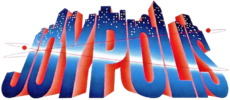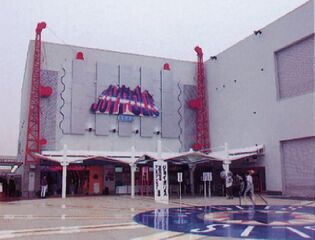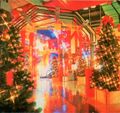Difference between revisions of "Yokohama Joypolis"
From Sega Retro
m (→Opening) |
|||
| (29 intermediate revisions by 3 users not shown) | |||
| Line 4: | Line 4: | ||
| name=Yokohama Joypolis | | name=Yokohama Joypolis | ||
| location=神奈川県横浜市中区新山下1丁目14番18号, Japan | | location=神奈川県横浜市中区新山下1丁目14番18号, Japan | ||
| − | | opened=1994-07-20{{ | + | | opened=1994-07-20{{magref|bemega|1994-08|31}} |
| closed=2001-02-28{{ref|https://web.archive.org/web/20010606012700/http://www.sega.co.jp/sega/atp/yokohama/home.html}} | | closed=2001-02-28{{ref|https://web.archive.org/web/20010606012700/http://www.sega.co.jp/sega/atp/yokohama/home.html}} | ||
}} | }} | ||
| − | '''Yokohama Joypolis''' (横浜ジョイポリス), later '''Joypolis H. Factory Yokohama''' (ジョイポリスH.FACTORY横浜), was the first [[Joypolis]] indoor theme park opened by [[Sega]]. Alongside the earlier [[Osaka ATC Galbo]], the park was one of the original two locations opened under the [[Amusement Theme Park]] concept in 1994, becoming the company's flagship amusement | + | '''Yokohama Joypolis''' (横浜ジョイポリス), later '''Joypolis H. Factory Yokohama''' (ジョイポリスH.FACTORY横浜), was the first [[Joypolis]] indoor theme park opened by [[Sega]]. Alongside the earlier [[Osaka ATC Galbo]], the park was one of the original two locations opened under the [[Amusement Theme Park]] concept in 1994,{{fileref|Amusement Theme Park JP Booklet.pdf}} becoming the company's flagship amusement facility during the mid 1990s. It has since been closed permanently and demolished. |
| − | |||
| − | |||
| − | |||
| − | |||
| − | |||
| − | |||
| − | |||
| − | |||
| − | |||
| − | |||
| − | |||
| − | |||
| − | |||
| − | |||
| − | |||
| − | |||
| − | |||
| − | |||
| − | |||
| − | |||
| − | |||
| − | |||
==Story== | ==Story== | ||
| − | Yokohama Joypolis was themed around a conceptual story involving a fictional professor, "Dr. Chrono", and the "B.U.R.P." (Basic Universal Reflector Prism),{{ref|http://www.ibiblio.org/GameBytes/issue21/misc/joypolis.html}} a device which, in its physical form, involved the escalators linking the floors of the centre together.{{magref|segamagjp|5|19}} "Dr Chrono" was first used for Osaka ATC Galbo and would go on to feature in the other two Galbo locations | + | [[File:Yokohama Interior.jpg|thumb|left|The "B.U.R.P." escalator device created by "Dr. Chrono", used as the centrepiece theme story aspect in Yokohama Joypolis]] |
| + | Yokohama Joypolis was themed around a conceptual story involving a fictional professor, "Dr. Chrono", and his creation, the "B.U.R.P." (Basic Universal Reflector Prism),{{ref|http://www.ibiblio.org/GameBytes/issue21/misc/joypolis.html}} a device which, in its physical form, involved the escalators linking the floors of the centre together.{{magref|segamagjp|5|19}} "Dr Chrono" was first used for Osaka ATC Galbo and would go on to feature in the other two Galbo locations. | ||
{{Translation | {{Translation | ||
| lang1=jp | | lang1=jp | ||
| lang2=en | | lang2=en | ||
| text1=天才発明家"Dr.クロノ"。 | | text1=天才発明家"Dr.クロノ"。 | ||
| − | 横浜 新山下に秘密の研究所を持つ彼の目的は、「"時"の破壊」。 | + | 横浜 新山下に秘密の研究所を持つ彼の目的は、「"時"の破壊」。 日常という「時の流れ」に支配され、いつもと同じ「空間」で変化のない毎日を過ごすことに何の疑問も抱かずに生きる人々にとてつもない衝撃を与えるために、彼は研究を重ねてきた。そして、ついに『時空間位相変調装置(BURP)』が出来上がった。『BURP』を稼働させれば、「時」を歪ませ、「空間」にひずみをつくり、人々を「時の流れ」から解放させることができる。ところが、この事態を時空間管理局(タイム・ポリス)がキャッチし、彼の実験を妨げようとする。"Dr.クロノ"は、『BURP』を守るために、研究所をアミューズメントテーマパーク 『ジョイポリス』としてカモフラージュした。彼の研究成果は7種類の時空間を体験できるアトラクションにより体験できる。{{ref|https://web.archive.org/web/19961224105313/http://www.sega.co.jp/sega/atp/yokohama/story.html}} |
| − | |||
| − | "Dr.クロノ"は、『BURP』を守るために、研究所をアミューズメントテーマパーク 『ジョイポリス』としてカモフラージュした。彼の研究成果は7種類の時空間を体験できるアトラクションにより体験できる。 | ||
| text2=Genius Inventor "Dr. Chrono" | | text2=Genius Inventor "Dr. Chrono" | ||
| − | Yokohama "Destruction of 'Time' "--that's the aim of Dr. Chrono who has a secret laboratory in Shin-Yamashita. He's been struggling through one experiment after another, just to give an astonishing impact to those who, ruled by the "current of time", will never question the way they spend days in the same old "space". | + | Yokohama "Destruction of 'Time' "--that's the aim of Dr. Chrono who has a secret laboratory in Shin-Yamashita. He's been struggling through one experiment after another, just to give an astonishing impact to those who, ruled by the "current of time", will never question the way they spend days in the same old "space". At last, he has succeeded in inventing the "*Phase Modulator of Time and Space* (BURP)". "BURP" allows both "time" and "space" to be warped, so that people can be set free from the "current of time". As luck would have it, however, the Time Police catch-on to news of his discovery and try to stop him from continuing his experiments. To protect "BURP", "Dr. Chrono" disguises his laboratory by turning it into an amusement park "JOYPOLIS". You can try the fruits of his research in our attractions that allow you to encounter seven different dimensions of time and space.{{ref|https://web.archive.org/web/19970216130449/http://www.sega.co.jp/sega_e/atp/yokohama/story.html}} |
| + | }} | ||
| − | + | ==History== | |
| + | {{mainArticle|{{PAGENAME}}/History}} | ||
| − | + | ==Attractions== | |
| + | ===Original attractions=== | ||
| + | {{multicol| | ||
| + | *''[[Rail Chase: The Ride]]'' (20-07-1994 - 28-02-2001) | ||
| + | *''[[Ghost Hunters]]'' (20-07-1994 - 10-09-1995) | ||
| + | *''[[Mad Bazooka]]'' (20-07-1994 - 28-02-2001) | ||
| + | *''[[Astronomicon]]'' (20-07-1994 - 11-1996) | ||
| + | *''[[AS-1]]'' (20-07-1994 - 1998) | ||
| + | *''[[VR-1]]'' (20-07-1994 - 28-02-2001) | ||
| + | *''[[Virtua Formula]]'' (20-07-1994 - 28-02-2001) | ||
}} | }} | ||
| − | |||
| − | == | + | ===Later attractions=== |
{{multicol| | {{multicol| | ||
| − | *'' | + | *''IMAX Ridefilm'' (1996 - 28-02-2001) |
| − | + | *''[[Murder Lodge]]'' (12-1996 - 28-02-2001) | |
| − | + | *''[[Fortune Museum]]'' (12-1996 - 28-02-2001) | |
| − | + | *''[[Power Sled]]'' (1997 - 28-02-2001) | |
| − | + | *''[[The Lost World: Jurassic Park Special]]'' (1998- 28-02-2001) | |
| − | + | *''[[MaxFlight VR2002]]'' (1999 - 28-02-2001) | |
| − | |||
| − | *''[[Murder Lodge]]'' | ||
| − | *''[[Fortune Museum]]'' | ||
| − | *''[[Power Sled]]'' | ||
| − | *''[[The Lost World: Jurassic Park Special]]'' | ||
| − | *'' | ||
}} | }} | ||
| + | |||
| + | ==Videos== | ||
| + | *[https://segaretro.org/File:Famitsu_Game_Catalog_2_Joypolis_1995.mp4 Segments of the 01/07/1995 edition of ''Famitsu'' television series '' Game Catalog II'' filmed at Yokohama Joypolis] | ||
| + | *[https://segaretro.org/File:Rail_Chase_The_Ride_JP_Promotional_Video.mp4 Promotional video for ''Rail Chase: The Ride''] | ||
| + | *[https://segaretro.org/File:VR-1_JP_Promotional_Video.mp4 Promotional video for ''VR-1''] | ||
| + | *[https://segaretro.org/File:Ghost_Hunters_JP_Promotional_Video.mp4 Promotional video for ''Ghost Hunters''] | ||
| + | *[https://segaretro.org/File:Mad_Bazooka_JP_Promotional_Video.mp4 Promotional video for ''Mad Bazooka'' (no sound)] | ||
| + | *[https://segaretro.org/File:AS1_JP_Promotional_Video.mp4 Promotional video for ''AS-1'' (no sound)] | ||
==Gallery== | ==Gallery== | ||
<gallery> | <gallery> | ||
| − | + | JoypolisYokohama Outside.jpg|Yokohama Joypolis exterior, circa July 1994 | |
| − | + | Yokohama Joypolis 1994.jpg | |
| + | YokohamaJoypolis giftshop.png|Gift shop | ||
| + | YokohamaJoypolis medalgames.png|Medal games | ||
| + | Yokohama Interior.jpg|"B.U.R.P." | ||
| + | Yokohama VR1 Exterior.jpg |VR-1 | ||
| + | Yokohama VR1.jpg | ||
| + | Yokohama VR1 2.jpg | ||
| + | Yokohama VR1 3.jpg | ||
| + | Yokohama VR1 4.jpg | ||
| + | YokohamaJoypolis AS1 ScrambleTraining.png|AS-1 | ||
| + | YokohamaJoypolis Indy500.png|''[[Indy 500]]'' | ||
| + | Yokohama RailChase.jpg|''Rail Chase: The Ride'' | ||
| + | Yokohama RailChase 2.jpg | ||
| + | YokohamaJoypolis MadBazooka entrance.png|''[[Mad Bazooka]]'' | ||
| + | Madbazooka.jpg|''[[Mad Bazooka]]'' | ||
| + | Yokohama_Mad_Bazooka.jpg|''[[Mad Bazooka]]'' | ||
| + | Yokohama_Xmas_94_Exterior.jpg|Exterior circa December 1994 | ||
| + | Yokohama_Xmas_94_Interior.jpg | ||
| + | Yokohama_Xmas_94_Interior_2.jpg | ||
| + | Yokohama Virtua Fighter Eternal Battle 2.jpg|Virtua Fighter Eternal Battle event, February 1995 | ||
| + | Yokohama Virtua Fighter Eternal Battle 2 02.jpg | ||
| + | Yokohama Sega Rally Time Attack Festival.jpg|Sega Rally Time Attack Festival event, circa mid 1995 | ||
| + | Yokohama_GSJ_1995.jpg|Photo of Skate GSJ meet held circa June 1995 | ||
JoypolisHFactoryYokohama Outside.jpg|Joypolis H. Factory Yokohama circa early 2000s | JoypolisHFactoryYokohama Outside.jpg|Joypolis H. Factory Yokohama circa early 2000s | ||
JoypolisHFactoryYokohama Inside.jpg | JoypolisHFactoryYokohama Inside.jpg | ||
| + | YokohamaJoypolis GhostHunters2 entrance.png|''Ghost Hunters II'' entrance | ||
| + | GhostHuntersII_Yokohama.jpg|''Ghost Hunters II'' exterior circa February 2001 | ||
| + | MadBazooka_Yokohama.jpg|''Mad Bazooka'' exterior circa February 2001 | ||
| + | MadBazooka_Yokohama_2.jpg | ||
</gallery> | </gallery> | ||
| Line 78: | Line 93: | ||
==Promotional material== | ==Promotional material== | ||
<gallery> | <gallery> | ||
| − | + | File:Amusement Theme Park JP Booklet.pdf|1994 promotional booklet for the [[Amusement Theme Park]] concept featuring Yokohama Joypolis | |
| − | + | Yokohama Joypolis JP Booklet 96.jpg|Late 1996 leaflet | |
| − | + | Yokohama Joypolis JP Booklet 96 2.jpg | |
| − | + | Joypolis H Factory JP Booklet 00.jpg|2000 leaflet | |
| + | Joypolis H Factory JP Booklet 00 2.jpg | ||
</gallery> | </gallery> | ||
| + | |||
==External links== | ==External links== | ||
| − | + | * [https://web.archive.org/web/19970216123314/http://www.sega.co.jp/sega/atp/yokohama/home.html 1997 sega.jp homepage] (archived) | |
| + | * [https://web.archive.org/web/19990418081035/http://www.sega.co.jp/sega/atp/yokohama/home.html 1999 sega.jp homepage] (archived) | ||
==References== | ==References== | ||
| + | {{ref|https://retrocdn.net/images/3/38/Harmony_JP_130.pdf}} | ||
<references /> | <references /> | ||
{{clear}} | {{clear}} | ||
{{Joypolis}} | {{Joypolis}} | ||
Latest revision as of 01:38, 24 March 2024

|

|
| Yokohama Joypolis |
|---|
| Location: 神奈川県横浜市中区新山下1丁目14番18号, Japan |
| Opened: 1994-07-20[1] |
| Closed: 2001-02-28[2] |
Yokohama Joypolis (横浜ジョイポリス), later Joypolis H. Factory Yokohama (ジョイポリスH.FACTORY横浜), was the first Joypolis indoor theme park opened by Sega. Alongside the earlier Osaka ATC Galbo, the park was one of the original two locations opened under the Amusement Theme Park concept in 1994,[3] becoming the company's flagship amusement facility during the mid 1990s. It has since been closed permanently and demolished.
Contents
Story
Yokohama Joypolis was themed around a conceptual story involving a fictional professor, "Dr. Chrono", and his creation, the "B.U.R.P." (Basic Universal Reflector Prism),[4] a device which, in its physical form, involved the escalators linking the floors of the centre together.[5] "Dr Chrono" was first used for Osaka ATC Galbo and would go on to feature in the other two Galbo locations.
- 日本語
- English
History
- Main article: Yokohama Joypolis/History.
Attractions
Original attractions
- Rail Chase: The Ride (20-07-1994 - 28-02-2001)
- Ghost Hunters (20-07-1994 - 10-09-1995)
- Mad Bazooka (20-07-1994 - 28-02-2001)
- Astronomicon (20-07-1994 - 11-1996)
- AS-1 (20-07-1994 - 1998)
- VR-1 (20-07-1994 - 28-02-2001)
- Virtua Formula (20-07-1994 - 28-02-2001)
Later attractions
- IMAX Ridefilm (1996 - 28-02-2001)
- Murder Lodge (12-1996 - 28-02-2001)
- Fortune Museum (12-1996 - 28-02-2001)
- Power Sled (1997 - 28-02-2001)
- The Lost World: Jurassic Park Special (1998- 28-02-2001)
- MaxFlight VR2002 (1999 - 28-02-2001)
Videos
- Segments of the 01/07/1995 edition of Famitsu television series Game Catalog II filmed at Yokohama Joypolis
- Promotional video for Rail Chase: The Ride
- Promotional video for VR-1
- Promotional video for Ghost Hunters
- Promotional video for Mad Bazooka (no sound)
- Promotional video for AS-1 (no sound)
Gallery
Magazine articles
- Main article: Yokohama Joypolis/Magazine articles.
Promotional material
1994 promotional booklet for the Amusement Theme Park concept featuring Yokohama Joypolis
External links
- 1997 sega.jp homepage (archived)
- 1999 sega.jp homepage (archived)
References
- ↑ Beep! MegaDrive, "August 1994" (JP; 1994-07-08), page 31
- ↑ http://www.sega.co.jp/sega/atp/yokohama/home.html (Wayback Machine: 2001-06-06 01:27)
- ↑ File:Amusement Theme Park JP Booklet.pdf
- ↑ http://www.ibiblio.org/GameBytes/issue21/misc/joypolis.html
- ↑ Sega Magazine, "1997-03 (1997-03)" (JP; 1997-02-13), page 19
- ↑ http://www.sega.co.jp/sega_e/atp/yokohama/story.html (Wayback Machine: 1997-02-16 13:04)
- ↑ http://www.sega.co.jp/sega/atp/yokohama/story.html (Wayback Machine: 1996-12-24 10:53)
- ↑ https://retrocdn.net/images/3/38/Harmony_JP_130.pdf
| Joypolis venues |
|---|
| Current |
| Tokyo Joypolis (1996) | Shanghai Joypolis (2014) | Qingdao Joypolis (2015) |
| Former |
| Shinjuku Joypolis (1996-2000) | Niigata Joypolis (1995-2001) | Yokohama Joypolis (1994-2001) | Fukuoka Joypolis (1996-2001) | Kyoto Joypolis (1997-2002) | Umeda Joypolis (1998-2018) | Okayama Joypolis (1998-2018) | Joypolis VR Shibuya (2018-2020) |

































